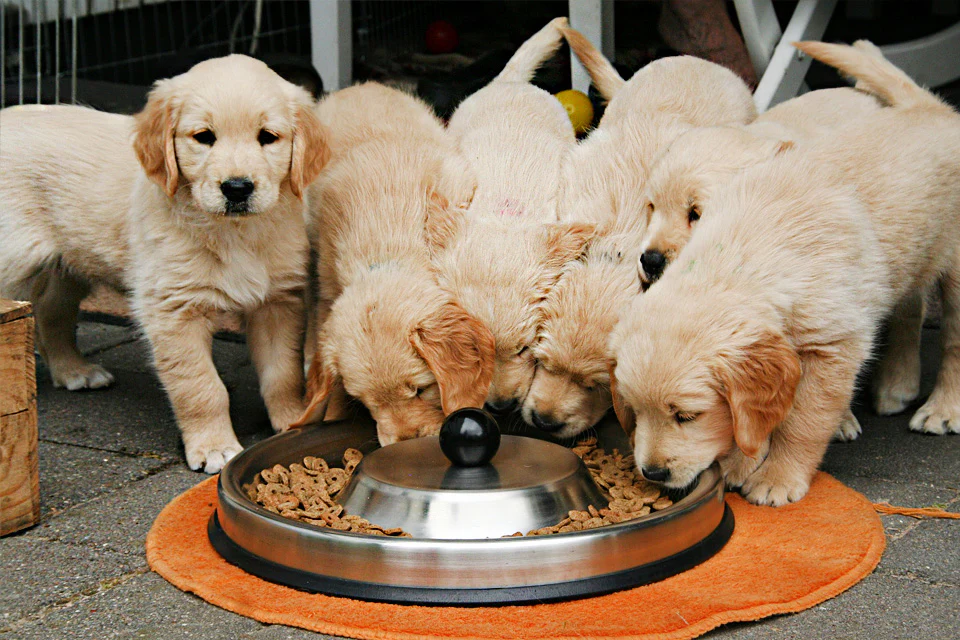Golden Retrievers are beloved for their gentle nature, loyalty, and energetic personality. To keep them thriving, they need a balanced diet suited to their specific breed characteristics. In this guide, we explore the best dog food for Golden Retrievers, breaking down what to look for, the ideal ingredients, and top recommendations for all life stages.
Golden Retriever Profile Biographie Table
| Attribute | Details |
| Breed Name | Golden Retriever |
| Origin | Scotland, United Kingdom |
| Size Category | Large |
| Weight Range | 55 to 75 lbs (25 to 34 kg) |
| Lifespan | 10–12 years |
| Temperament | Friendly, Intelligent, Loyal |
| Activity Level | High |
| Common Health Concerns | Hip dysplasia, skin allergies, obesity |
| Ideal Diet Type | High-protein, moderate-fat, grain-inclusive or grain-free with omega fatty acids |
Understanding the Nutritional Needs of Golden Retrievers
Golden Retrievers require a balanced blend of protein, fats, carbohydrates, vitamins, and minerals to maintain their health. Because they are prone to obesity and joint problems, choosing food that supports weight control and joint care is essential.
Key Ingredients in the Best Dog Food for Golden Retrievers
When searching for the best dog food for Golden Retrievers, look for these essential nutrients:
- High-Quality Animal Proteins like chicken, salmon, or lamb.
- Omega-3 and Omega-6 Fatty Acids for skin and coat health.
- Glucosamine and Chondroitin for joint support.
- Fiber to aid digestion and prevent obesity.
- Limited Fillers to avoid allergies and excess weight.
Best Dog Food for Golden Retriever Puppies
Golden Retriever puppies need more calories, DHA for brain development, and a calcium/phosphorus ratio to support growing bones.
Top Recommendation:
Royal Canin Golden Retriever Puppy Dry Dog Food
- Specially designed for Golden Retriever puppies.
- Includes antioxidants and prebiotics for immunity and digestion.
Alternative Option:
Wellness CORE Puppy Grain-Free Dry Dog Food
- High protein and DHA-rich for development.
- Grain-free, ideal for sensitive stomachs.
Best Dog Food for Adult Golden Retrievers
Adult Goldens need a maintenance diet with adequate energy, joint care ingredients, and minimal fillers.
Top Recommendation:
Blue Buffalo Life Protection Formula Large Breed
- Deboned chicken and brown rice formula.
- Contains glucosamine and chondroitin.
Alternative Option:
Hill’s Science Diet Adult Large Breed
- Vet-recommended, with optimal calcium for bone health.
- Omega-6 and vitamin E for skin and coat.
Best Dog Food for Senior Golden Retrievers
Older Goldens benefit from food lower in fat but high in joint-supporting nutrients and antioxidants.
Top Recommendation:
Nutro Natural Choice Large Breed Senior
- Contains glucosamine and chondroitin for aging joints.
- No artificial flavors or preservatives.
Alternative Option:
Orijen Senior Dog Food
- Biologically appropriate and protein-rich.
- Packed with fresh regional ingredients.
Wet vs. Dry Dog Food for Golden Retrievers
Golden Retrievers can enjoy both wet and dry food. However, dry kibble is generally more convenient and promotes dental health.
- Dry Food Benefits: Cost-effective, dental support, longer shelf life.
- Wet Food Benefits: Hydration boost, palatable, easier to chew for older dogs.
A mix of both can be ideal, especially for picky eaters or senior dogs with dental issues.
Grain-Free vs. Grain-Inclusive Dog Food
Some Golden Retrievers may develop sensitivities to grains. While grain-free foods are trending, it’s essential to check with your vet since some studies link grain-free diets to canine heart issues.
- Choose Grain-Free if your Golden shows signs of allergies or digestive issues.
- Choose Grain-Inclusive if your dog tolerates grains well and you prefer whole-food ingredients like brown rice or oatmeal.
Homemade Diets: Are They Safe for Golden Retrievers?
While homemade diets can offer control over ingredients, they must be well-balanced. Consult with a canine nutritionist to ensure the diet includes:
- Protein source (e.g., chicken, beef, turkey)
- Healthy carbs (e.g., brown rice, sweet potato)
- Vegetables (e.g., spinach, carrots)
- Supplements (e.g., fish oil, calcium)
Homemade meals without veterinary guidance may lead to nutrient deficiencies.
Treats and Snacks: What’s Safe for Golden Retrievers?
Opt for treats that are:
- Low in fat and calories.
- Free of artificial additives.
- Made with limited, natural ingredients.
Examples: Freeze-dried liver, carrots, green beans, or grain-free biscuits. Always feed treats in moderation—no more than 10% of daily calorie intake.
Common Feeding Mistakes to Avoid
- Overfeeding: Leads to obesity and joint stress.
- Too Many Treats: Can upset the nutritional balance.
- Ignoring Age-specific Needs: Puppies, adults, and seniors need different nutrients.
- Not Reading Labels: Always check ingredient lists and guaranteed analysis panels.
Transitioning to a New Dog Food
When switching your Golden Retriever’s diet, transition over 7–10 days by gradually mixing in the new food to prevent digestive upset.
Day-by-Day Ratio Example:
| Day | Old Food | New Food |
| 1-2 | 75% | 25% |
| 3-4 | 50% | 50% |
| 5-6 | 25% | 75% |
| 7+ | 0% | 100% |
Conclusion
Choosing the best dog food for Golden Retrievers depends on their age, health condition, and lifestyle. Whether you’re feeding a playful pup, an active adult, or a mellow senior, a balanced and breed-specific diet can help your Golden Retriever live a long, happy, and healthy life.
Read more: What is Pulse Mode on Geek Bar? Full Guide to Features & Benefits
FAQs About Best Dog Food for Golden Retrievers
A1: Royal Canin Golden Retriever Puppy and Wellness CORE Puppy Grain-Free are both excellent choices with balanced nutrients and DHA.
A2: Yes, but only if they show sensitivity to grains. Always consult a vet before switching to a grain-free formula.
A3: Puppies should be fed 3 times a day. Adults do well with 2 meals per day.
A4: Avoid chocolate, onions, garlic, grapes, raisins, and foods high in fat or salt.
A5: They can be, but must be guided by a vet to avoid nutrient deficiencies.
A6: Dry food helps dental health, but wet food can be added for palatability and hydration. A combination is often ideal.







